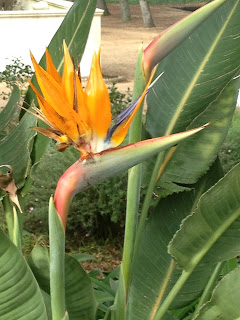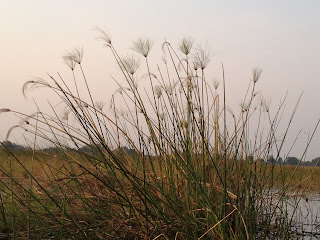One of the game walks I was particularly looking forward to was with an expert on rhinos. He was an expert guide on other things too (including an alarming array of easy to prepare posions), but his big thing are big things. Pretty well the biggest things, apart from some of the larger elephants.
The plight of the rhinoceros has been in the news for quite some time. It's all to do with their horns. Because of their size and power, it is believed to be an aprodisiac in some countries, such as China. The horn is made of keratin, the same material as hair or finger nails, and not bone. It has as much medicinal value as chewing your fingernail, which means nothing. But traditional, cultural myths are hard to fight against, and so rhino horns are worth hundreds of thousands dollars on the black market. Imagine living in a poor country, with a large family to feed, and no job, and maybe HIV AIDs medication to pay for. It's not hard to imagine you would be tempted to poach a rhino horn and set yourself up financially for life.
Rhino horn has also traditionally been used for the handle of ceremonial daggers in some countries in the Middle East. Again, the rhino's strength and aggression are why their horns are so prized. And if you are from India or China, and you have always grown up thinking rhino products are of value, and you can now afford what your father couldn't, it's not hard to see why you would want to have these items of elevated status.
The big problem is that the populations of China and India are huge. Almost 1.5 billion in China and 1.25 billion in India. They are the two most densely populated countries on the planet, and account for about 36% of the world's population. I can't quite get my head around that, because neither China or India are the largest countries by land mass. That honour goes to Russia and Canada respectively. Russia is the largest country in the world, but it's population is 143 million, while Canada, as the second largest country, has the puny population of 36 million. Together Russia and Canada make up 2 and a half percent of the world's peoples, compared with 36%
So there is a big problem with poachers killing rhinos for their horn. They come in at night, with guns to stun the animal and saws to take off the horn. Sometimes a trusted guide or a vet turns criminal and come in a helicopter, shooting from the air, swoop down, get the horn and there they go. Then the poor rhino is left to die, bleeding to death, sometimes over days. It's very cruel.
 |
| skeleton of a white rhino killed for his horn |
 |
| Note the gaping hole where the horn was cut off |
 |
| And note the bullet hole |
Educating people about the issue is the key of course, but there's a problem. We are running out of time. Or rather, rhinos are running out of time. Rhino mommies have just one baby at a time, and two years apart. So they take quite a long time to reproduce, and they are dying much quicker than that.
There are five different species of rhino: Javan (in Java), Sumatran (in Sumatra), Asian one-horned (in India), White and Black (both in Africa). In 1988 everyone thought Javan rhinos were already extinct, but there are actually about 60. Not zero, but pretty darn close. 60!!! Sumatran rhinos are the smallest, but considered the most critically endangered because their 1000 or so are scattered and not so protected as some of the other animals in national parks. Efforts are now being made breed those in captivity to try to save the species. Asian one-horned rhinos have only one horn (well, duh!) and can swim but that doesn't protect their numbers from being not much above 2500. Once found living across the whole of Southern Africa in the hundreds of thousands, the white rhino was considered extinct in the late 19th century, but then a tiny population was found and now there are about 10,000 white rhinos, which sounds like a lot, but not compared to what they would be without poaching. The black rhinos number anywhere from 2500 to 5000 depending on which saurce you believe. There are some that believe the world will be completely without rhinos by the year 2020. By the way, white and black rhinos did not earn their name due to colour. White rhinos have a wide mouth, as they eat only grass, whereas black rhinos have a sort of beaked overbite to bite off the twigs and bushes they eat besides grass. The only theory vis a vis names is that the Dutch (Afrikans) "Weid mond rhino”, means “Wide-mouth rhino.” but the Brits thought they were saying “white" and that was that.
Some ideas to thwart the poachers include harvesting the horns at intervals and sell them through legitimate channels, with proceeds going to further breeding programs. Others are to hire armed guards for every park (and almost every rhino), with directions to shoot to kill. Fencing programs are the simplest idea. Identifying horn products by their DNA to nab sellers and thus black market enforcers is perhaps the most complex idea.
Certainly one of my favourite safari moments was sitting low to the ground near 3 female white rhinos with a guide who has known one of them from the day she was born. He called in a low 'moo' sound, which they knew, and they allowed us to hunch closer. Then the guide ushered us to sit one at a time with "the girls" right behind us to have our photo taken. One person considered it the supreme act of confidence to turn your back on 3 full grown rhinos only about 10 metres away! But I never thought about that. It seemed a natural thing to do and I placed my trust in the best of human and animal nature.


























.jpg)
.jpg)

.jpg)
.jpg)













































